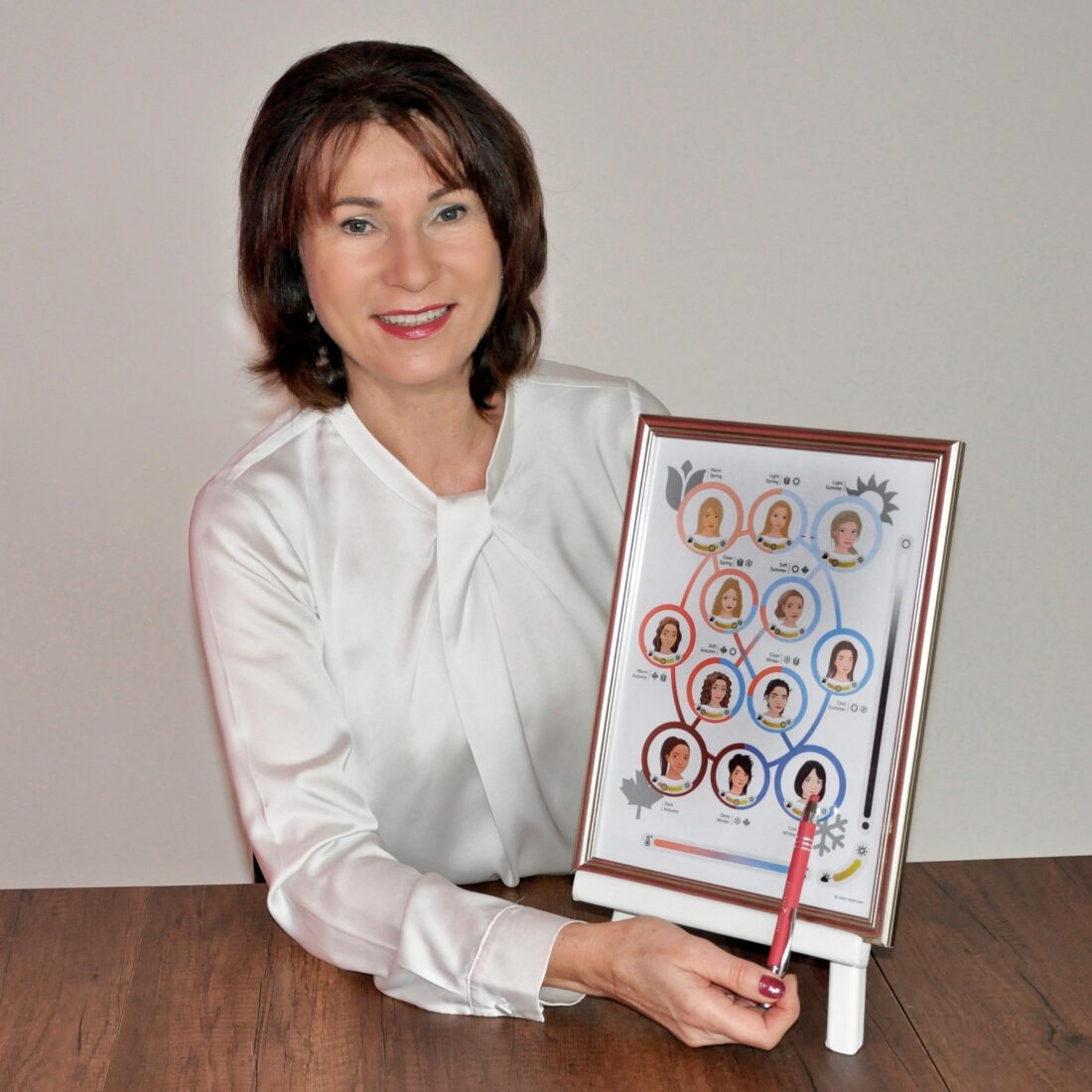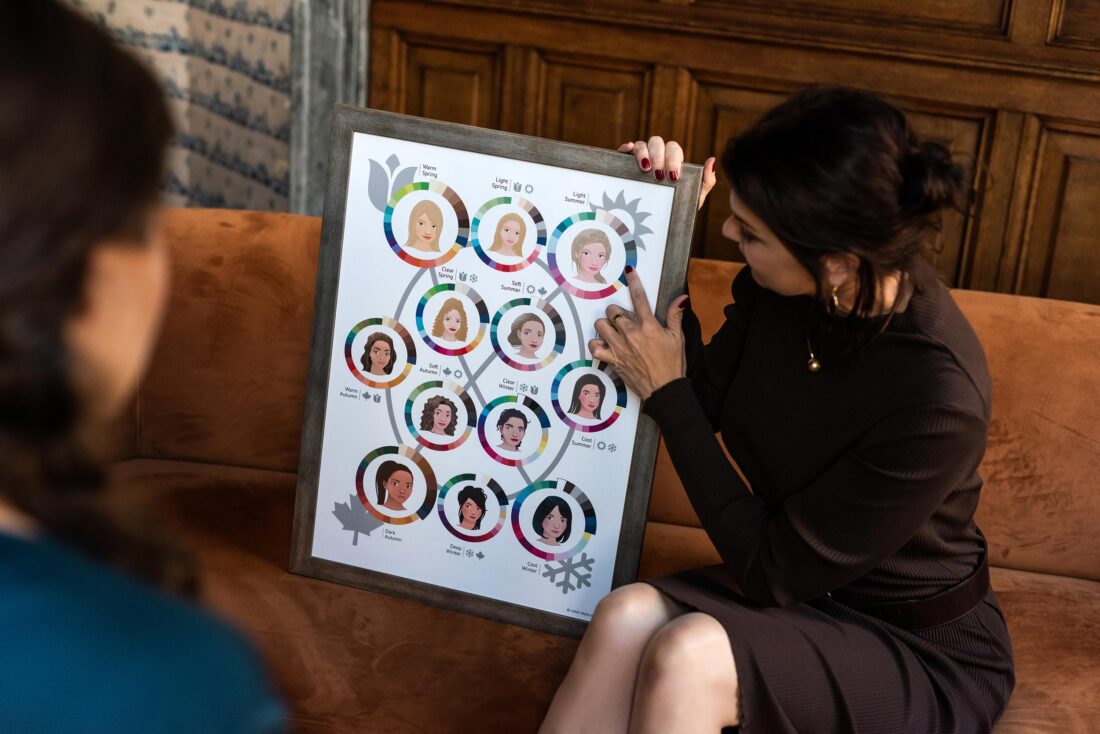
Interview met Regina Maass over haar 12-seizoensysteem
Regina Maass is de founder van de Kolibri Campus in Hamburg. Ze doceert wereldwijd en is een icoon op het gebied van individuele kleurconsultancy met haar 12-seizoensysteem.
Als personal styliste werk ik graag met dit systeem om gedetailleerde paletten te maken, gebaseerd op twaalf verschillende kleurtypes.
Ik werk nauw met Regina samen om deze methode ook in Nederland te introduceren. Dat vroeg natuurlijk om een interview:
Regina: “The best outfit is useless if the color isn’t right. The total package of a good outfit is style and colour.”
What is so unique about your structure?
Regina: “Let me first explain, that every color, every color family and every person has 3 dimensions or characteristics related to hair, skin, iris and eyebrows. This is where we have colors on us. These characteristics are temperature, brightness and saturation.
I divide each of these three dimension into 3 gradations and not just in 2 as it is usual with other systems. The division only into two is too inaccurate, too coarse. We don’t just have light and dark, soft and clear or warm and cool. My color system is extended by a middle category.
In addition, each color family has a clearly defined color spectrum. There shouldn’t be any inaccuracies like ‘as a cool-toned type you somehow also have a tendency to be warm-toned’. It must be clear and comprehensible for the customer where, in terms of color, his warm-toned tendency lies.”
What makes it better then others?
Regina: “My system is logically constructed — in other words, understandable to everyone and at the same time, customer-oriented. The usual 12-color-type system doesn’t seem to have a uniform structure. Since a guideline is missing confusion arises from several variants and alternatives, and the different names used for one and the same color family.
Consultants who have not learned a clear structure for color consulting often feel insecure, which is one reason why consultants who have already been trained elsewhere book me. And of course, a lack of structure leads to incorrect results.
Plus, overall, color consultation focuses too much on eye color. This often leads in the wrong direction. I’ll give another example: Blue eyes are considered cool toned. However, they occur in 10 of the 12 color types, i.e. also in the warm-toned types. If I focus on the cool-toned eyes and infer a cool-toned guy, I gave him the wrong advice. However, hair and skin are much larger carriers of color on us. That’s why I’m focusing on these.”
How did you come up with this structure?
Regina: “First of all, I am a structured person. This may sound boring and stiff (but I’m neither one nor the other). Many years ago I had training in differentiated color analysis. The structure used there was quite good, but not thought through to the end. I realized that without a good structure, the results are poor. But quality is one of my values.
I have experienced many customers who were wrongly advised. That showed me that the training is not good enough. I wanted (and can) do better. I would like to train consultants who deliver good results, which is fun for them and their customers. Those who come from me should leave with quality. Apart from the fact that I enjoy the training, that is my great motivation.”

Why 12 types and not more or less?
Regina: “If I have less than 12 color families, I cannot advise individually enough. There would be too many customers whose types were not recorded correctly and who were then assigned the wrong color type.
If I have more, I run the risk of confusing the customer because the system is no longer comprehensible to him. But above all, the customer is restricted too much in terms of color. I give an example: the customer can wear a certain pink, but supposedly no longer a similar one. This means that shopping is no longer fun and the color consulting is in danger of enslaving in terms of color.”
In how many countries is your structure being used?
Regina: “I’ll just list the countries from which I had trainees for my color consultation. These are definitely Germany, Austria, Switzerland, Great Britain, The Netherlands, Denmark, Italy, Slovakia,, Dubai, Australia, USA, Brazil.
It might be used elsewhere, but I can’t say for sure.”
Why should Dutch colour consultants (working so far with 4 color families) or style advisors get aquinted with differentiated colour analysis?
Regina: “It is true for both groups that they advise better, in the sense of more individual.
Enough customers notice/feel that, consulted by the 4 color type system, the color type they are supposed to be is wrong. They don’t feel comfortable with “their” colors and don’t stick to them. Ultimately, their color consultations were pointless.
More and more customers are better informed and are realizing that differentiated color systems with more than just four color families exist. These customers want color consultants who are trained in a much more differentiated manner.
Style consultants can do a good job. But the best outfit is useless if the color isn’t right. The total package of a good outfit is style and colour. Otherwise it’s only half the battle. Imagine a wonderful dress, perfect fit, perfect length, with an interesting design, but unfortunately it makes the wearer look pale.”
Je vindt meer over Regina op de Kolibri Image website (in het Duits):
